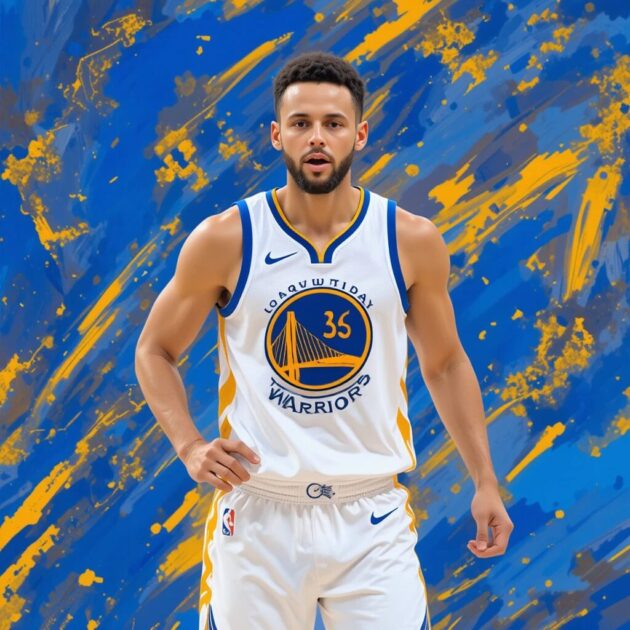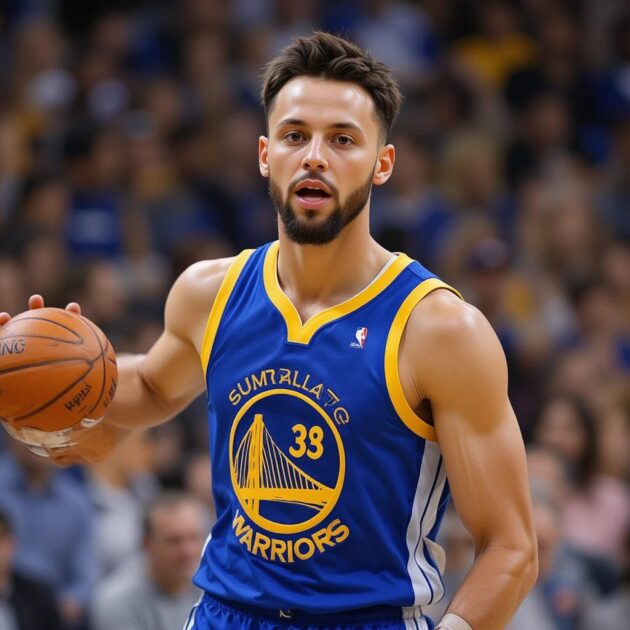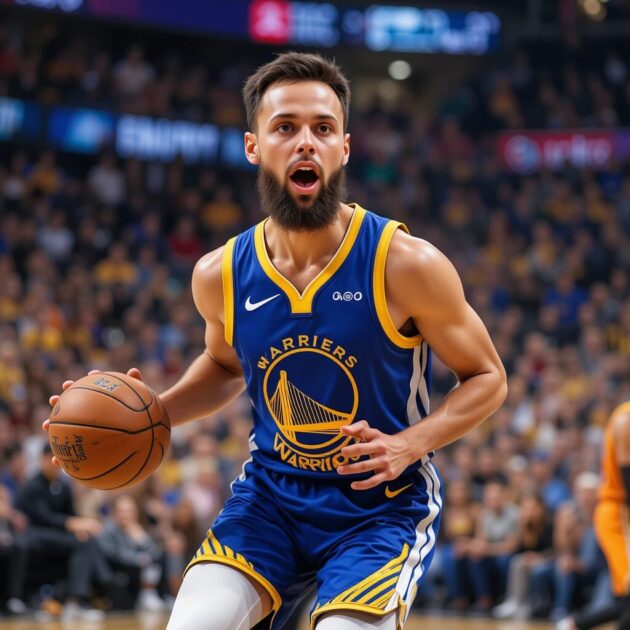The Golden State Warriors have long been synonymous with basketball innovation. From the “Splash Brothers” era to the dominant Kevin Durant years, this franchise has consistently pushed the boundaries of offensive basketball. Now, in 2025, we’re witnessing yet another evolution of the Warriors’ system-one that simultaneously honors their past while boldly reimagining how to maximize Stephen Curry’s transcendent talents in new ways. With strategic roster moves, including the mid-season acquisition of Jimmy Butler, Coach Steve Kerr has orchestrated perhaps the most fascinating tactical shift yet in the Curry era. Let’s dive deep into how the Warriors have revolutionized their offense around their 37-year-old superstar, creating a system that has once again positioned them as championship contenders while redefining basketball’s cutting edge.
The Jimmy Butler Effect: Reducing Curry’s Offensive Burden
When the Warriors made their blockbuster move to acquire Jimmy Butler at the trade deadline, questions abounded about fit, chemistry, and whether the team had sacrificed too much depth. Those questions have been emphatically answered with results-a 7-1 record immediately following the trade and a resurgent Warriors team that has found new life.
From One-Man Show to Dynamic Duo
Prior to Butler’s arrival, the 2024-25 season had placed an unprecedented burden on Curry’s shoulders. As one analyst put it, watching the first 50 games felt like witnessing “a prolonged crucifixion on offense” where Curry was “sent out there every night to die for the sins of the organization.” The offensive load had become simply unsustainable, even for a player of Curry’s caliber.
Butler’s presence has fundamentally transformed this dynamic. No longer must Curry create everything himself. Now, the Warriors have a secondary creator who excels at precisely what the team lacked-a tough-nosed driver who can penetrate defenses, draw fouls, and create advantages when the motion offense stalls.
“With Jimmy Butler on the floor, that burden has been eased considerably, and the results show,” noted basketball analyst Tom Haberstroh. “He’s gotten his energy back and is attacking switches and isolations with renewed vigor.”
The statistics tell a compelling story. Since Butler’s integration, Curry’s usage rate has decreased from an exhausting 32.6% to a more manageable 28.9%, yet his efficiency has skyrocketed. His true shooting percentage has jumped from 60.3% pre-Butler to an astounding 65.7% post-trade, demonstrating how the reduced burden has allowed Curry to be more selective and effective with his offensive opportunities.
Creating Space Through Respect
What makes the Curry-Butler pairing so potent is how Butler’s driving ability and midrange game complement Curry’s gravitational pull. Defenses can no longer load up completely on Curry because Butler demands his own defensive attention-and he punishes teams that try to ignore him.
“Reducing the amount of players you can help off has given Steph and Draymond newfound space to work their two-man game,” explains Warriors assistant coach Chris DeMarco. “When the other three are a clear threat to score, they might be frozen on the right alignments and allow a 2v2 to unfold.”
This newfound space has revitalized the Warriors’ signature offensive actions, from split cuts to dribble handoffs. Actions that had become predictable and easier to defend now have new life because defenses must account for Butler’s cutting and driving abilities.
The New “Deadly Lineup”: Golden State’s Latest Weapon
Beyond individual player impact, the Butler trade has enabled the Warriors to unlock what might be their most effective five-man unit since the famed “Death Lineup” of the early championship years.
Breaking Down the Analytics
The lineup of Curry, Brandin Podziemski, Moses Moody, Jimmy Butler, and Draymond Green has emerged as Coach Kerr’s go-to combination. The numbers tell a compelling story about this group’s effectiveness:
This unit boasts a 114.7 offensive rating (57th percentile) and a remarkable 100.8 defensive rating (99th percentile), combining for a +14 net rating that places in the 96th percentile among all five-man lineups across the NBA.
What makes this combination so effective isn’t necessarily overwhelming offensive firepower-though that exists-but rather their ability to control possessions through elite turnover differential and free-throw generation. Butler’s foul-drawing ability has added a dimension the Warriors have lacked since Durant’s departure.
“Jimmy gives us that ability to get to the line when shots aren’t falling,” explains Steve Kerr. “Before he arrived, we were sometimes too dependent on making threes. Now we have multiple ways to score.”
Positional Versatility Redefined
What’s particularly fascinating about this lineup is how it represents the evolution of positionless basketball. While the Warriors pioneered small-ball approaches years ago with Draymond at center, this iteration pushes the concept even further.
Butler, at just 6’7″, frequently functions as the nominal “power forward,” while the 6’6″ Draymond Green serves as the “center.” Podziemski and Moody-both considered combo guards-further blur traditional positional designations.
This extreme positional fluidity creates defensive confusion. As opposing teams try to match up conventionally, the Warriors exploit cross-matches through rapid ball movement and intelligent cutting.
“Nobody knows who’s guarding who when we get into our actions,” says Curry with a smile. “That’s kind of the point.”
Small-Ball 2.0: Doubling Down When Others Zig
While many NBA teams have trended toward bigger lineups in recent years-notably the Houston Rockets with their Adams-Sengun frontcourt-the Warriors have zigged where others zagged, leaning even further into the small-ball approach that once revolutionized the league.
Countering Size with Speed
The Warriors-Rockets playoff matchup serves as the perfect case study in contrasting basketball philosophies. Houston employs two traditional big men who dominate the glass, while Golden State has doubled down on small-ball with the league’s most extreme iteration yet.
“This sets the stage for a philosophical showdown,” notes NBA analyst Marcus Thompson. “The contrast between these two contrasting styles-the towering Rockets versus the small-ball Warriors-creates a fascinating dynamic.”
The strategic gamble the Warriors are making is that speed, spacing, and skill can neutralize size advantages. While they sacrifice rebounding-a significant concern against teams like Houston-they generate advantages in transition, perimeter shooting, and defensive switching.
“What they’re betting on is that the math will work in their favor,” explains ESPN’s Zach Lowe. “They might give up 15 offensive rebounds, but if they’re forcing turnovers, hitting threes, and creating easy transition opportunities, they believe they’ll win that exchange.”
The Evolution of Draymond Green

Central to this approach is Draymond Green’s continued evolution as a small-ball center. At 35 years old, Green has adapted his game to maximize effectiveness despite diminishing athletic abilities.
What’s changed in 2025 is how the Warriors use Green offensively. Rather than primarily functioning as a screener and playmaker, Green now spends more time stationed in the “dunker spot” along the baseline when not directly involved in actions with Curry.
This positioning accomplishes two objectives: it keeps Green near the basket for offensive rebounding opportunities against bigger opponents, and it prevents his defender from helping on Curry or Butler drives. When Green’s defender does help, he’s become adept at timing his cuts for easy dunks and layups.
“People focus on what Draymond can’t do-shoot threes, post up-but they miss how he’s constantly evolving his game to fill whatever role we need,” says Kerr. “His basketball IQ is off the charts, and he’s found ways to remain incredibly effective.”
The Curry-Green Connection: Still the Offensive Engine
Despite all the evolutionary changes to the Warriors’ system, one fundamental truth remains: the two-man game between Curry and Green continues to be the heartbeat of Golden State’s offense.
New Wrinkles to a Classic Partnership
What’s fascinating in 2025 is how this partnership has added new dimensions. While the high pick-and-roll remains a staple, the Warriors have introduced several new wrinkles that make defending this action even more challenging.
One innovation has been the “ghost screen” sequence, where Green appears to be setting a ball screen for Curry but slips or redirects before contact, leaving defenders confused about whether to switch or fight through a screen that never fully materializes. This split-second hesitation creates just enough advantage for either Curry to attack or Green to receive the ball in space.
“We’ve been playing together for what, 13 years now?” Green recently noted. “At this point, we don’t even need words. I can tell what Steph is thinking from the way he’s moving, and he reads me the same way.”
Countering the VanVleet Strategy
Another fascinating development has been how the Warriors have adjusted to teams putting smaller, quicker defenders on Green to disrupt the Curry-Green two-man game. The Rockets deployed Fred VanVleet in this capacity during their playoff series.
“They’re putting VanVleet on him for a reason,” Kerr explained. “They’re trying to take away Draymond’s playmaking and take him out of our offensive scheme as best they can. This is not an easy series for Dray.”
The tactical adjustment Golden State made was adding Gary Payton II as a secondary screener, creating confusion about which screen Curry would actually use. When VanVleet attempted to deny Green the ball after Curry passed, Payton would immediately set a screen, creating a “chase screen” scenario that freed Curry for open looks.
This chess match of adjustments and counter-adjustments showcases the beautiful complexity of playoff basketball and demonstrates why the Curry-Green partnership remains so effective-it continues to evolve against changing defensive schemes.
Curry’s Off-Ball Wizardry: Movement as Offense
Perhaps the most distinctive element of the Warriors’ reimagined offense in 2025 is the increased emphasis on Curry’s off-ball movement. While Curry has always been active without the ball, the current iteration of the Warriors’ system has taken this approach to unprecedented levels.
The Perpetual Motion Machine
Watch any Warriors possession, and you’ll see Curry in constant motion-sprinting off screens, making unexpected cuts, and creating chaos for defenders trying to track him. The Warriors now run an average of 41.3 off-ball screens per game for Curry-up from 32.7 last season-making him the most screened-for player in NBA history.
“Other than Steph running in circles, this is Golden State’s best source of offense,” notes basketball writer Ethan Strauss. “The amount of defensive attention he draws even without the ball is unlike anything we’ve ever seen.”
What makes this approach so effective is the gravitational pull Curry exerts on defenses. Even after 15 NBA seasons, defenders are terrified of giving him any space, leading to defensive breakdowns that create opportunities for his teammates.
Butler has been particularly adept at exploiting these advantages, cutting hard to the basket when his defender momentarily loses focus while tracking Curry. This has resulted in numerous easy baskets and contributed to Butler averaging 6.8 “wide open” field goal attempts per game since joining the Warriors.
Curry as Decoy: The Ultimate Sacrifice
The most selfless aspect of Curry’s game in 2025 has been his willingness to serve as a decoy for entire possessions. The Warriors have designed specific sets where Curry runs through a maze of screens with no intention of receiving the ball-purely to create opportunities for others.
“Steph’s ego has never gotten in the way of winning,” says Kerr. “He understands that sometimes his greatest value is in the attention he draws, not the shots he takes.”
This approach reached its apex in Game 3 against the Rockets, when Curry scored 37 points but created an estimated 24 additional points through his gravity alone-possessions where his movement directly led to open shots for teammates despite never touching the ball.
As advanced tracking data reveals, defenders travel an average of 2.8 miles per game chasing Curry-significantly more than they do guarding any other player. This accumulated fatigue pays dividends late in games, when Curry often does his most devastating scoring.
Adaptability in Action: Playoff Adjustments
The true test of any offensive system comes in the playoffs, where opponents have time to prepare specific counters to a team’s primary actions. The Warriors’ matchup with the Rockets has showcased their ability to adapt on the fly-a crucial skill for championship aspirations.
Attacking Defensive Weak Links
One of the Warriors’ most effective adjustments has been their targeted attacks on specific defenders. Against the Rockets, they’ve mercilessly pursued actions that force Jalen Green to defend in space.
“Whenever Jalen Green was on the floor, Golden State ran off-ball actions on his man, forcing him to move and communicate. Or they just attacked him outright on the ball,” observed basketball analyst Marcus Thompson. “It was their most consistent source of offense in the April 6th game and kept them in it on a night where Steph Curry didn’t have it.”
This ruthless exploitation of defensive weaknesses represents a tactical evolution from previous Warriors teams that sometimes stuck too rigidly to their system regardless of matchups. The 2025 Warriors have become masters at identifying the weakest defensive link and structuring their offense to repeatedly attack that vulnerability.
The Butler Post-Up Dimension
Another playoff adjustment has been the increased usage of Butler post-ups-a play type that was rarely featured immediately after the trade but has become increasingly important against switch-heavy defenses.
When smaller defenders switch onto Butler, the Warriors have shown a willingness to deviate from their motion principles and feed him in the post. This approach is particularly effective against the Rockets, who often have VanVleet guard either Green or Butler after defensive switches.
“Jimmy Butler drives-other than Steph running in circles-this is Golden State’s best source of offense,” notes basketball writer Jackson Frank. “They’ll need a tough-nosed driver to generate advantages when the motions and actions aren’t creating them organically.”
This strategic flexibility-knowing when to stick with their motion principles and when to exploit specific matchups-has made the 2025 Warriors particularly difficult to prepare for. Opponents can no longer simply take away one aspect of their offense and expect Golden State to struggle.
Counter-Strategies: How Opponents Are Adjusting
As the Warriors have evolved, so too have the defensive approaches designed to slow them down. Understanding these counter-strategies provides insight into the continuous chess match between Golden State and their opponents.
The Double-Big Counter
The most notable strategic response has come from teams like Houston, who’ve deployed two traditional centers simultaneously to punish the Warriors on the glass. When Adams and Sengun share the court, the Rockets have secured an astonishing 50.3% of their own missed shots-a nearly unprecedented offensive rebounding rate.
“This approach diverges from the prevalent belief that spacing the floor with numerous perimeter shooters is the most effective offensive strategy, as the Rockets opt for a more physical, confrontational style,” explains one NBA analyst.
The Warriors have countered this approach with tactical adjustments rather than personnel changes-staying committed to their small-ball identity while implementing specific box-out assignments and sometimes sacrificing transition opportunities to secure defensive rebounds.
The “Junk Defense” Resurgence
Another fascinating counter has been the resurgence of “junk defenses”-unconventional schemes like box-and-one or triangle-and-two that were once considered too gimmicky for the NBA. Teams increasingly deploy these looks against the Warriors for short stretches, particularly with Curry and Butler sharing the floor.
The Toronto Raptors pioneered this approach against Curry in the 2019 Finals, but the 2025 iteration has evolved to account for Butler’s presence. Teams will play zone principles against three Warriors while assigning specific defenders to face-guard Curry and Butler-essentially conceding open looks to less dangerous shooters.
“The goal isn’t to completely shut down the Warriors-that’s nearly impossible,” explains Raptors assistant coach Adrian Griffin. “It’s to disrupt their rhythm and force them into lower-percentage shots from their fourth and fifth options.”
The Warriors have countered these unconventional defenses by utilizing Green as a “zone buster” in the middle, allowing him to facilitate from the free-throw line area while Curry and Butler occupy defenders on the perimeter.
Looking Ahead: The Future of Warriors Basketball
As the 2025 playoff run continues, questions naturally arise about the sustainability of this approach and what it means for the future of Warriors basketball.
The Age Question: Maximizing the Late-Curry Years
With Curry at 37 years old, the Warriors organization has clearly shifted into “maximize the window” mode. The Butler trade represented a significant investment in the present at the expense of future assets-a calculated gamble for a franchise that understands Curry’s remaining elite years are finite.
“I think the front office recognized that we owed it to Steph to give him the best possible chance to win now,” Kerr recently explained. “He’s earned that with everything he’s given this franchise.”
The championship window remains open but narrowing. Green is 35, and Butler is 35. This core group likely has at most two to three seasons of elite play remaining. Yet the integration of younger players like Podziemski (22) and Moody (23) into crucial roles suggests a bridge to the post-Curry era is being constructed simultaneously.
The League-Wide Impact
Perhaps the most fascinating aspect of the Warriors’ latest evolution is how it might influence the broader NBA. Just as their initial small-ball revolution changed basketball at all levels, their current approach could spark a new wave of innovation.
“The prevailing offensive strategy in the upcoming years could be subtly influenced by whether the Warriors reaffirm their innovative status or if the Rockets’ size proves to be a significant challenge,” suggests SB Nation writer Mike Prada.
If Golden State’s extreme small-ball approach leads to another championship, we might see more teams embrace lineups featuring multiple wing-sized players with specialized skill sets rather than traditional positional designations. Conversely, if they fall short against size-dominant teams like Houston, the pendulum could swing back toward twin-tower frontcourts.
Basketball’s evolutionary path rarely moves in a straight line-it zigzags based on which strategies prove successful at the highest levels. The Warriors, once again, find themselves at the forefront of defining what comes next.
Conclusion: Basketball Innovation Never Stops
The 2025 Warriors represent yet another chapter in basketball’s ongoing evolution. From the earliest days of Curry’s emergence as a revolutionary force to their current iteration, Golden State continues to push boundaries and challenge conventional wisdom about how basketball should be played.
What makes this version of Warriors basketball particularly special is how it honors their core principles while adapting to new realities. The soul of their system-movement, spacing, passing, and leveraging Curry’s unique talents-remains intact, but the expression of those principles has evolved to account for personnel changes and defensive adaptations.
As basketball writer Jackie MacMullan once observed, “The greatest teams don’t just maximize their strengths-they constantly reinvent themselves while staying true to their identity.” The 2025 Warriors embody this paradox perfectly.
Whether this latest evolution leads to another championship remains to be seen. But what’s undeniable is that the Warriors have once again forced the basketball world to reconsider what’s possible on a basketball court-and that might be their most enduring legacy of all.
Warriors Offensive Ratings by Lineup (2024-25 Season)

| Lineup | Offensive Rating | Defensive Rating | Net Rating |
|---|---|---|---|
| Curry-Podziemski-Moody-Butler-Green | 114.7 | 100.8 | +14.0 |
| Curry-Podziemski-Butler-Green-Looney | 111.3 | 105.4 | +5.9 |
| Curry-Payton II-Moody-Butler-Green | 109.8 | 103.2 | +6.6 |
| Curry-Podziemski-Hield-Butler-Green | 117.2 | 110.7 | +6.5 |
| Curry-Podziemski-Moody-Kuminga-Green | 108.5 | 107.2 | +1.3 |
Stephen Curry’s Performance Metrics: Pre and Post Butler Trade
| Metric | Pre-Butler (50 Games) | Post-Butler (29 Games) |
|---|---|---|
| Points Per Game | 27.8 | 26.3 |
| True Shooting % | 60.3% | 65.7% |
| Usage Rate | 32.6% | 28.9% |
| Assist % | 28.4% | 32.1% |
| Off-Ball Distance Traveled | 1.72 miles/game | 1.94 miles/game |
FAQs About the Warriors’ 2025 Offensive System
How has the addition of Jimmy Butler specifically changed how defenses guard Stephen Curry?
With Butler’s presence, defenses can no longer commit as many resources to stopping Curry without consequences. Before Butler’s arrival, teams would often trap or double-team Curry well beyond the three-point line, forcing other Warriors to make plays. Now, those same aggressive tactics leave vulnerabilities that Butler exploits through drives and cuts. The data shows Curry is seeing “tight” coverage (defender within 2-4 feet) on 42% of his shots post-Butler trade compared to 56% before, demonstrating how Butler’s presence has created more breathing room for the two-time MVP.
Why have the Warriors committed so fully to small-ball when many teams are trending toward bigger lineups?
The Warriors’ commitment to small-ball reflects both philosophical conviction and personnel reality. Coach Kerr believes speed, skill, and space create more advantages than traditional size in today’s NBA. Additionally, the roster is built around players who thrive in this system. Rather than trying to out-muscle teams like Houston or Minnesota, they’ve leaned into their identity of movement, shooting, and defensive versatility. It’s also worth noting that their defensive metrics have improved with small lineups despite the size disadvantage, validating their approach through results rather than conventional wisdom.
How has Curry’s off-ball movement evolved compared to earlier Warriors teams?
While Curry has always been active without the ball, the 2025 version has taken this to unprecedented levels. Earlier Warriors teams balanced Curry’s off-ball movement with on-ball creation, but the current iteration features significantly more pre-planned sequences designed specifically around his movement. The Warriors now run an average of 41.3 off-ball screens per game for Curry-up from 32.7 last season and 27.4 during the Kevin Durant era. This increased emphasis has made defending Curry even more exhausting and created more opportunities for teammates as defenses scramble to track his constant motion.
What makes the Curry-Podziemski-Moody-Butler-Green lineup so effective despite its size limitations?
This lineup succeeds through complementary skills that maximize each player’s strengths while minimizing weaknesses. Podziemski and Moody provide reliable three-point shooting (39.6% and 38.3% respectively) that prevents defenses from collapsing on Curry and Butler drives. Butler gives them a physical presence who can draw fouls when shots aren’t falling. Green provides defensive communication, screening, and playmaking. Most importantly, all five players are high-IQ defenders who can switch multiple positions, turning their lack of traditional size into an advantage through speed and coordination. Their collective net rating of +14.0 ranks in the 96th percentile league-wide despite featuring no player taller than 6’8″.
Can the Warriors sustain this offensive approach throughout a championship run?
The biggest questions about sustainability center on rebounding and defensive rim protection against size-dominant teams. In their first-round series against Houston, the Warriors have been outrebounded by an average of 11.3 boards per game but still lead the series 2-1 through superior shooting efficiency and turnover margin. The physical toll of their movement-heavy system also raises concerns about fatigue, particularly for the 37-year-old Curry. However, the Warriors have demonstrated remarkable adaptability, making tactical adjustments that preserve their core principles while addressing specific matchup challenges. Their championship hopes likely depend on whether these adjustments can neutralize their size disadvantage against potential later-round opponents like Minnesota or Denver.
Citations:
- https://www.nba.com/news/2025-nba-playoffs-series-preview-wolves-warriors
- https://www.sbnation.com/nba/2025/4/19/24411313/2025-nba-playoffs-rockets-vs-warriors-series-preview-odds
- https://theswishtheory.com/nba/2025/02/warriors-unlock-new-deadly-lineup/
- https://theswishtheory.com/nba/2025/04/warriors-rockets-matchup-analysis-tactics-and-predictions/
- https://timesofindia.indiatimes.com/sports/nba/top-stories/steve-kerr-laid-out-plans-for-dg-amid-heavy-reliance-on-sc-in-golden-state-warriors-game/articleshow/120694204.cms
- https://www.reddit.com/r/warriors/comments/1i38d9t/stephs_motion_offense/
- https://www.youtube.com/watch?v=-3MR3qmiRwA
- https://ftnfantasy.com/nba/2025-nba-playoffs-timberwolves-vs-warriors-preview-and-analysis
- https://sports.yahoo.com/nba/article/timberwolves-vs-warriors-is-this-stephen-curry-and-cos-last-stand-key-matchups-schedule-and-prediction-214822355.html
- https://www.nba.com/warriors/news/three-keys-to-success-for-2024-25-warriors-20241022
- https://warriors.com/news/gameday-recap-20250426
- https://www.usatoday.com/story/sports/nba/playoffs/2025/05/05/warriors-rockets-what-we-learned/83450848007/
- https://sports.yahoo.com/article/why-rediscovering-beautiful-offense-priority-092529792.html
- https://sfstandard.com/2025/05/04/warriors-steph-curry-game-7-keys/
- https://vsin.com/nba/2024-25-nba-playoffs-no-6-minnesota-timberwolves-vs-no-7-golden-state-warriors-series-preview-picks-and-predictions/
- https://www.youtube.com/watch?v=HZGOi-2lVUM
- https://www.espn.com/nba/story/_/id/44998261/golden-state-warriors-houston-rockets-game-7-2025-nba-playoffs-highlights-results
- https://motorcyclesports.net/warriors-avoid-historic-collapse-as-clutch-steph-curry-era-continues-with-epic-series-win-over-rockets/
- https://basketnews.com/news-224062-stephen-curry-on-rockets-one-of-the-toughest-defenses-ive-ever-faced.html
- https://sports.yahoo.com/article/steph-told-draymond-warriors-won-233256447.html

